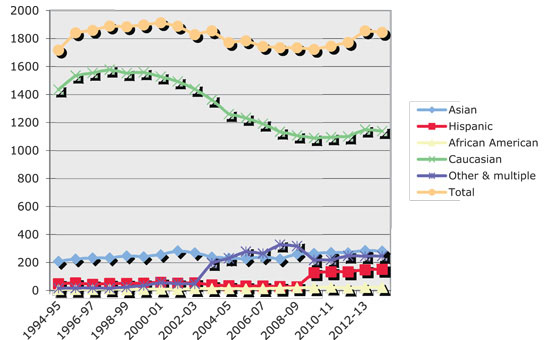|
|
Published October 8th, 2014
|
Moraga School District Plans for the Future
|
|
| By Sophie Braccini |
 |
| (source: California Department of Education) |
There are 1,861 students enrolled in the Moraga School District this year, spread across three elementary schools and a middle school. Over the years enrollment figures have fluctuated wildly, with a high of 2,718 in 1973 and a low of 1,418 in 1984. What the future holds for Moraga schools is hard to predict-these ample fluctuations were not the result of housing development but rather of other demographic factors. For school district superintendent Bruce Burns, this is a serious concern that needs addressing; the number of students and their location helps plan construction, districting boundaries, and the number of classrooms and teachers. So the district hired a consultant and, before the end of the year, will have the results of a demographic study that will narrow the range of possibilities for enrollment. These figures will feed the district's ongoing strategic plan.
 Planning is tantamount to any leadership position and in education, changes can be deep and come in rapid succession. "Last year we had the most change ever," says Burns, referring to his 29 years in the school system. He lists the implementation of the Common Core standards, the transition from STAR testing to an online testing system, and the implementation of the Local Control Funding Formula, the state's new mechanism to fund schools in California. With LCFF came the requirement for a new reporting system, the Local Control Accountability Plan. "We finished our three-year strategic plan," says Burns. "About 80 percent of the information required in the Local Control Accountability Plan is contained in our strategic plan."
Planning is tantamount to any leadership position and in education, changes can be deep and come in rapid succession. "Last year we had the most change ever," says Burns, referring to his 29 years in the school system. He lists the implementation of the Common Core standards, the transition from STAR testing to an online testing system, and the implementation of the Local Control Funding Formula, the state's new mechanism to fund schools in California. With LCFF came the requirement for a new reporting system, the Local Control Accountability Plan. "We finished our three-year strategic plan," says Burns. "About 80 percent of the information required in the Local Control Accountability Plan is contained in our strategic plan."
 Developing a strategic plan was one of Burns' top goals when he took the job in 2010; he wanted the process to include the widest and most inclusive outreach. Now the plan is formalized and it measures the progression of each goal as time passes. "We have materialized our plan on the wall of the auditorium at Joaquin Moraga Intermediate," says Burns. "Each category is presented as a tree, and each time we reach a goal, we add a fruit in the tree." The four trees are named Student Achievement, Community Inclusiveness, Fiscal Stability, and Curriculum and Instruction.
Developing a strategic plan was one of Burns' top goals when he took the job in 2010; he wanted the process to include the widest and most inclusive outreach. Now the plan is formalized and it measures the progression of each goal as time passes. "We have materialized our plan on the wall of the auditorium at Joaquin Moraga Intermediate," says Burns. "Each category is presented as a tree, and each time we reach a goal, we add a fruit in the tree." The four trees are named Student Achievement, Community Inclusiveness, Fiscal Stability, and Curriculum and Instruction.
 On the community tree, the "collaboration with Saint Mary's College pear" now hangs; on the fiscal tree, the "apple of successful parcel tax" has been attached; and on the curriculum tree, the "peach of implementation of the math and English Common Core standards" hangs proudly, among many others.
On the community tree, the "collaboration with Saint Mary's College pear" now hangs; on the fiscal tree, the "apple of successful parcel tax" has been attached; and on the curriculum tree, the "peach of implementation of the math and English Common Core standards" hangs proudly, among many others.
 "Our plan is set for three years and not five because our environment changes rapidly," says Burns, "and now we will transition to the Local Control Accountability Plan that we have to submit every year." In the area of change, one of the big "ifs" is funding. "The LCFF is set to bring us back in 2020 to the level of funding we had in 2007-08, depending on positive economic growth," says Burns. He adds that MEF funding and the parcel tax have given the district some stability.
"Our plan is set for three years and not five because our environment changes rapidly," says Burns, "and now we will transition to the Local Control Accountability Plan that we have to submit every year." In the area of change, one of the big "ifs" is funding. "The LCFF is set to bring us back in 2020 to the level of funding we had in 2007-08, depending on positive economic growth," says Burns. He adds that MEF funding and the parcel tax have given the district some stability.
 Enrollment is also a big if. "We have three to five years of solid projections for the district; after that all we have are generalized estimates," says Burns. "The number of developments that are proposed in the town is such that we need to make sure we will have the capacity for the new residents."
Enrollment is also a big if. "We have three to five years of solid projections for the district; after that all we have are generalized estimates," says Burns. "The number of developments that are proposed in the town is such that we need to make sure we will have the capacity for the new residents."
 The superintendent was not aware that in 2008, when the Moraga Center Specific Plan was approved, the environmental impact study prepared by the town's consultant found that the school district had enough capacity for the number of new homes proposed. "We have hired a demographer who will look at birthrates, enrollment trends, proposed development, and will estimate a 'student generation rate.'" Burns says that the heart of the district's concern is the facilities that haven't had significant attention since the mid '90s. "We need to look at renovation, seismic retrofit, and if we need to increase capacity we will have to build new classrooms." The alternative would be to increase class size- Burns notes that in the '70s, when the district was teaching almost 1,000 more students than it is today, the average class size was more than 30 students, rather than the 20-something of today.
The superintendent was not aware that in 2008, when the Moraga Center Specific Plan was approved, the environmental impact study prepared by the town's consultant found that the school district had enough capacity for the number of new homes proposed. "We have hired a demographer who will look at birthrates, enrollment trends, proposed development, and will estimate a 'student generation rate.'" Burns says that the heart of the district's concern is the facilities that haven't had significant attention since the mid '90s. "We need to look at renovation, seismic retrofit, and if we need to increase capacity we will have to build new classrooms." The alternative would be to increase class size- Burns notes that in the '70s, when the district was teaching almost 1,000 more students than it is today, the average class size was more than 30 students, rather than the 20-something of today.
 The Moraga School District's strategic plan can be found online at www.moraga.k12.ca.us.
The Moraga School District's strategic plan can be found online at www.moraga.k12.ca.us.

|
|
|
|
|
|
|
|
|
| |
|
|
|
|




